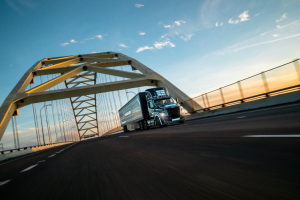 By Larissa Koehler and Casey Horan
By Larissa Koehler and Casey Horan
One year ago today, 15 states and Washington D.C. took a major step toward improving the health of people and our planet by committing to work collaboratively toward decarbonizing their trucking industries. As part of this agreement, these states have vowed to ensure 100% of medium- and heavy-duty vehicles sales will be zero-emitting by 2050, with an interim goal of 30% by 2030.
The Northeast States for Coordinated Air Use Management Multi-State ZEV Action Plan demonstrates a recognition from many states that they can and should lead the charge on emissions reduction because of the associated economic, environmental and public health benefits of a zero-emissions future.
Governors from states not yet a part of this MOU should consider signing on as soon as possible if they want to help shape the implementation of this transition. Furthermore, policymakers should view the overarching goal of 100% ZEV sales by 2050 as an important first step and strive for more ambition — namely to achieve 100% MHD ZEV sales by 2040.
Of course, as with anything else, this sales target doesn’t exist in a vacuum — a suite of directives is needed to ensure the necessary infrastructure and economic support will be available for the transition. In California, for example, this includes policies aimed at market support (known as the Zero Emission Market Development Strategy), state agency ZEV action plans and public-private partnerships tasked with accelerating deployment of affordable charging infrastructure. The Board of Public Utilities in New Jersey is also considering how to facilitate the adoption of MHD ZEVs via a recently published straw proposal that would increase access to charging stations.
States must continue driving progress on zero-emission trucks Share on XThriving EV market facilitates state action
Ambitious targets like this are possible due to an ever-improving EV market. As batteries get cheaper and companies race to innovate, MHD ZEVs have become increasingly cost competitive — especially when comparing total cost over the lifetime of the vehicle.
Additionally, titans of the industry like Daimler and Volvo are ramping up production for MHD ZEVs as quickly as possible. A recent analysis by EDF found that at least 125 zero-emission truck and bus models are in production, development or demonstration, and over the past 5 years, sales of zero-emission commercial vehicles have shot up by nearly a factor of 10.
What’s more — battery, fuel cell and charging technology is advancing rapidly, and engineers are working hard to resolve commonly cited inconveniences like long charging times, heavy load weights and weather inefficiencies. For example, companies like Toyota and SK Innovation are racing to deliver new solid-state EV batteries by 2025 that will significantly improve overall efficiency and could extend the range of EVs by up to 50%.
At the federal level, a new administration is setting the stage for better accommodation of MHD ZEVs on a large scale. President Biden’s proposed infrastructure plan — which is in addition to state infrastructure programs led by utilities — includes billions of dollars dedicated to EV infrastructure. An extensive network of charging stations across the country may alleviate much of the range anxiety felt by long-haul fleet owners.
The question here is not whether joining the NESCAUM MOU is feasible. We have a thriving EV market, investment from industry and a rapidly growing infrastructure network to support state action. The climate, health, and economic benefits of a zero-emissions future — and the consequences we face by not acting quickly — are already well-established.
That being said, states must evaluate how they can facilitate this transition by implementing smart policies that support the EV market and infrastructure deployment. And most importantly, states should treat the multi-state agreement as a first step and strive to do more.









